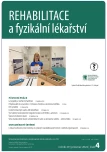Scale for the Assessment and Rating of Ataxia
Authors:
Merklová K.; Rejtarová A.; Angerová Y.
Authors‘ workplace:
Klinika rehabilitačního lékařství, 1. lékařská fakulta, Univerzita Karlova a Všeobecná fakultní nemocnice v Praze
Published in:
Rehabil. fyz. Lék., 29, 2022, No. 4, pp. 203-207.
Category:
Original Papers
doi:
https://doi.org/10.48095/ccrhfl2022203
Overview
The Department of Rehabilitation Medicine of the First Faculty of Medicine, Charles University and General Teaching Hospital in Prague has been dealing with patients after brain damage in a long term. Cerebellar ataxia is a very important symptom observed in these patients. The “Scale for the Assessment and Rating of Ataxia (SARA)” was chosen from the available evaluation tools, which was translated from English into Czech using the so-called “back translation” method. Subsequently, the applicability of the translation in practice was evaluated. The article describes the creation of the translation and the subsequent evaluation process. The translation was created with the help of two impartial translators on a native English speaker level and was continuously consulted with the supervisor. The evaluation process of the SARA translation consisted of the assessment of its usability by occupational therapists from the Czech Republic and the assessment of its usability by the author of the bachelor’s thesis on a sample of nine patients with cerebellar ataxia. An online questionnaire regarding the assessment was given to the occupational therapists. The work resulted in a translated SARA tool in the Czech language and in the evaluation of its applicability in occupational therapy practice.
Keywords:
occupational therapy – Cerebellar ataxia – ataxia evaluation – SARA
Sources
1. Scale for the assessment and rating of ataxia (SARA). [online]. Available from: http://www.ataxia-study-group.net/html/about/ataxiascales/sara.
2. Weyer A, Abele M, Schmitz-Hübsch T et al. Reliability and validity of the scale for the assessment and rating of ataxia: a study in 64 ataxia patients. Mov Disord 2007; 22(11): 1633–1637. doi: 10.1002/mds.21544.
3. Kim BR, Lim JH, Lee SA et al. Usefulness of the Scale for the Assessment and Rating of Ataxia (SARA) in ataxic stroke patients. Ann Rehabil Med 2011; 35(6): 772–780. doi: 10.5535/arm.2011.35.6.772.
4. Schmitz-Hübsch T, Tezenas du Montcel S, Baliko L et al. Scale for the Assessment and Rating of Ataxia: development of a new clinical scale. Neurology 2006; 66(11): 1717–1720. doi: 10.1212/01.wnl.0000219042.60538.92.
5. ATAXIA Global Initiative, worldwide platform for clinical research in ataxias. [online]. Available from: http://ataxia-global-initiatives.net/sara-training-tool-by-dzne/.
6. Shirley Ryan Ability Lab. Scale for Assessment and Rating of Ataxia. [online]. Available from: https://www.sralab.org/rehabilitation-measures/scale-assessment-
and-rating-ataxia.
7. Hall DA, Domingo SZ, Hamdache LZ et al. A good practice guide for translating and adapting hearing-related questionnaires for different languages and cultures. Int J Audiol 2018; 57(3): 161–175. doi: 10.1080/14992027.2017.
1393565.
8. Hendl J. Kvalitativní výzkum: základní teorie, metody a aplikace. Praha: Portál 2016.
9. World Health Organization. Process of translation and adaptation of instruments. [online]. Available from: https://www.who.int/substance_abuse/research_tools/translation/en/.
10. Krivošíková M. Úvod do ergoterapie. Praha: Grada 2011.
11. Lang CE, Bland MD, Bailey RR et al. Assessment of upper extremity impairment, function, and activity after stroke: foundations for clinical decision making. J Hand Ther 2013; 26(2):
104–115. doi: 10.1016/j.jht.2012.06.005.
12. Schwabová J, Zahálka F, Komárek V et al. Validita mezinárodní škály pro pacienty s ataxií. Cesk Slov Neurol N 2010; 2010(6): 689–693.
13. Merklova K. Hodnocení cerebelární ataxie z pohledu ergoterapeuta. Praha, 2022. Bakalářská práce. Univerzita Karlova, 1. lékařská fakulta,
Klinika rehabilitačního lékařství 1. LF UK a VFN. Vedoucí práce Anna Rejtarová.
Labels
Physiotherapist, university degree Rehabilitation Sports medicineArticle was published in
Rehabilitation & Physical Medicine

2022 Issue 4
- Hope Awakens with Early Diagnosis of Parkinson's Disease Based on Skin Odor
- Deep stimulation of the globus pallidus improved clinical symptoms in a patient with refractory parkinsonism and genetic mutation
Most read in this issue
- KISS syndrome
- Relaxation of shortened muscles in children by scootering
- Fine motor skills assessment limitations in selected standardized tests – perspective of occupational therapists
- Physical activity in patients with Crohn‘s disease and ulcerative colitis
